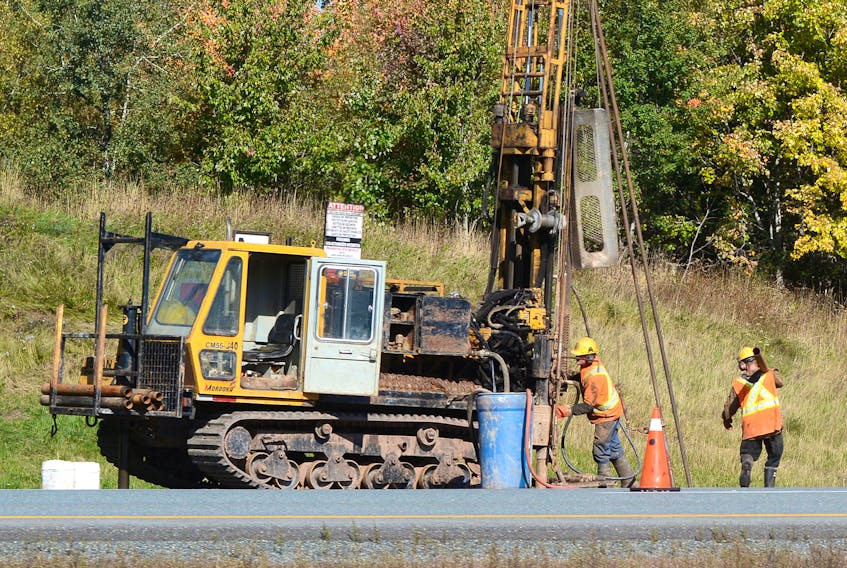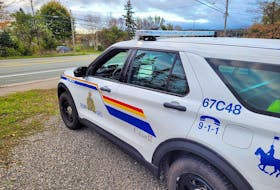OXFORD, N.S. — The provincial government has begun investigating the potential for sink hole development under the Trans-Canada Highway near Oxford.
Several weeks after saying it did not see the need to do additional testing of the highway, despite the presence of a depression, Transportation and Infrastructure Renewal has hired a company to conduct geotechnical testing in the area.
Logan Drilling, overseen by Harbourside Engineering, has begun a geotechnical investigation at Highway 104, Exit 6, near Oxford that should give a clear understanding of the conditions at the site and how best to monitor and/or respond to the findings going forward.
“We are very diligent about how we maintain safety on all our roads across the province. We’ve been monitoring that road closely for some time, especially since the nearby sinkhole appeared,” Transportation and Infrastructure Renewal Minister Lloyd Hines said Wednesday. “It was felt we needed to some additional due diligence there so we’re doing some geotechnical investigation.”
The minister said the department is confident in its monitoring process, but decided to take the additional step “to err on the side of caution” as highway safety is the highest priority.
Hines said it’s difficult to determine next steps until the data received from the investigation is analyzed.
Department spokesperson Marla MacInnis said site work began this week and will include the drilling of several boreholes.
“The depth of the drilling is expected to be between 100 and 125 feet below the roadway but could vary at each borehole location depending on subsurface conditions encountered,” she said.
The investigation is in addition to regular monitoring and annual road surface testing done at that location.
Sinkhole surfacing belies deeper problem

The testing comes a month after the Oxford Lions Club decided to abandon its parkland property in the community following the release of finding of a geotechnical study of the popular playground that was closed in August of 2018 when a massive sinkhole suddenly developed.
At the time, Cumberland-Colchester MP Bill Casey, Cumberland South MLA Tory Rushton and Cumberland EMO co-ordinator Mike Johnson joined Oxford CAO Rachel Jones in calling on the province to do additional testing focusing on the Trans-Canada Highway and Highway 321 that comes into Oxford.
Jones said the province was invited to participate in the study by GHD Engineering but declined and the engineering firm’s final report recommended additional study of the Trans-Canada Highway and the road into town. At the time, the province refused saying it regular does its own testing.
Casey said he’s pleased with the province’s decision.
“All along we’ve had these indications there could be a problem. Hopefully, this will clarify whether there is a problem or not,” Casey said. “I’m very much appreciative of the province taking the steps to confirm what’s going on there. It’s important we know.”
The MP said his biggest concern is not the potential lost commerce should a sinkhole open up, it’s the danger it would present should a tanker, a bus or a car fall into it.
“We all know how quickly the sinkhole developed in the park and we don’t want that to happen on the highway,” he said. “This analysis will hopefully provide peace of mind that won’t happen.”
We can fix it

Casey is hoping the testing is deep enough because that’s what the geologists said needed to be done. He’s also optimistic that if a problem is identified the provincial and federal governments will work quickly to mitigate it.
“There are sinkholes all over the world and there are construction methods to fix that before the hole opens up,” he said. “We don’t know if there is a sinkhole under there, but there are indications that there is.”
Rushton, who raised the issue in the legislature as recently as two weeks ago, said he was told by the minister the testing would be conducted within two weeks.
“It’s very welcome news that they have started drilling and testing because we need to know what’s underneath,” said Rushton. “Just because they find an issue or potential issues under the highway doesn’t mean the highway will get shut down. There are solutions for these things. In Florida, for instance, there are highways over sinkholes all over the place. They grout them and fill them in with proper mixture. It’s not the end of the world. Let them do the job and secure peace of mind for the motoring public. Let’s see what comes back from this testing and I will support TIR with whatever they find and whatever they do to make it safe. Hopefully they will confirm it is safe and nothing needs to be done.”
The sinkhole that closed the Lions Park in Oxford is located in an area of karst topography that is prone to sinkholes. There are sinkholes directly across the Trans-Canada from Oxford and there is aerial photography from before the highway’s construction indicating there many have been a sinkhole where the highway is today. LiDAR images, which hadn’t been completely analyzed in September, also indicated depressions around the highway.
Casey believes consistent calls from the municipal, provincial and federal levels and comments from a professor at Dalhousie University, as well as media attention, helped prod Transportation and Infrastructure Renewal into action.
“I think the overlay photographs with the existing highway and before the highway was built showing a sinkhole under the highway was convincing,” Casey said.
RELATED:









